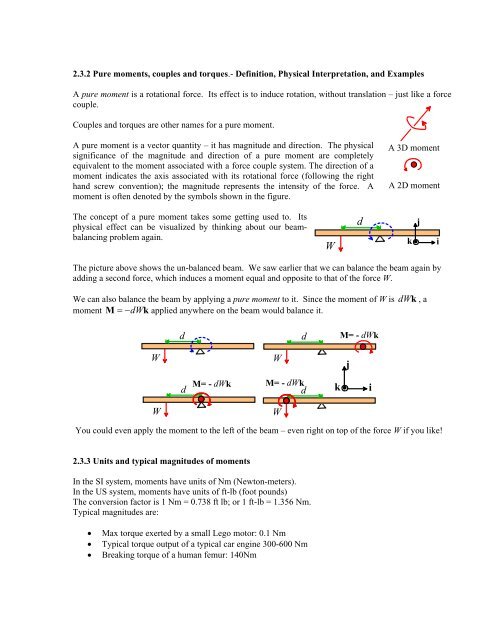Chapter 2 Review of Forces and Moments - Brown University
Chapter 2 Review of Forces and Moments - Brown University
Chapter 2 Review of Forces and Moments - Brown University
You also want an ePaper? Increase the reach of your titles
YUMPU automatically turns print PDFs into web optimized ePapers that Google loves.
2.3.2 Pure moments, couples <strong>and</strong> torques.- Definition, Physical Interpretation, <strong>and</strong> Examples<br />
A pure moment is a rotational force. Its effect is to induce rotation, without translation – just like a force<br />
couple.<br />
Couples <strong>and</strong> torques are other names for a pure moment.<br />
A pure moment is a vector quantity – it has magnitude <strong>and</strong> direction. The physical<br />
significance <strong>of</strong> the magnitude <strong>and</strong> direction <strong>of</strong> a pure moment are completely<br />
equivalent to the moment associated with a force couple system. The direction <strong>of</strong> a<br />
moment indicates the axis associated with its rotational force (following the right<br />
h<strong>and</strong> screw convention); the magnitude represents the intensity <strong>of</strong> the force. A<br />
moment is <strong>of</strong>ten denoted by the symbols shown in the figure.<br />
A 3D moment<br />
A 2D moment<br />
The concept <strong>of</strong> a pure moment takes some getting used to. Its<br />
physical effect can be visualized by thinking about our beambalancing<br />
problem again.<br />
W<br />
d<br />
k<br />
j<br />
i<br />
The picture above shows the un-balanced beam. We saw earlier that we can balance the beam again by<br />
adding a second force, which induces a moment equal <strong>and</strong> opposite to that <strong>of</strong> the force W.<br />
We can also balance the beam by applying a pure moment to it. Since the moment <strong>of</strong> W is dWk , a<br />
moment M =−dWk applied anywhere on the beam would balance it.<br />
d<br />
d<br />
M= - dWk<br />
W<br />
W<br />
j<br />
d<br />
M= - dWk M= - dWk<br />
d k i<br />
W<br />
W<br />
You could even apply the moment to the left <strong>of</strong> the beam – even right on top <strong>of</strong> the force W if you like!<br />
2.3.3 Units <strong>and</strong> typical magnitudes <strong>of</strong> moments<br />
In the SI system, moments have units <strong>of</strong> Nm (Newton-meters).<br />
In the US system, moments have units <strong>of</strong> ft-lb (foot pounds)<br />
The conversion factor is 1 Nm = 0.738 ft lb; or 1 ft-lb = 1.356 Nm.<br />
Typical magnitudes are:<br />
• Max torque exerted by a small Lego motor: 0.1 Nm<br />
• Typical torque output <strong>of</strong> a typical car engine 300-600 Nm<br />
• Breaking torque <strong>of</strong> a human femur: 140Nm
















